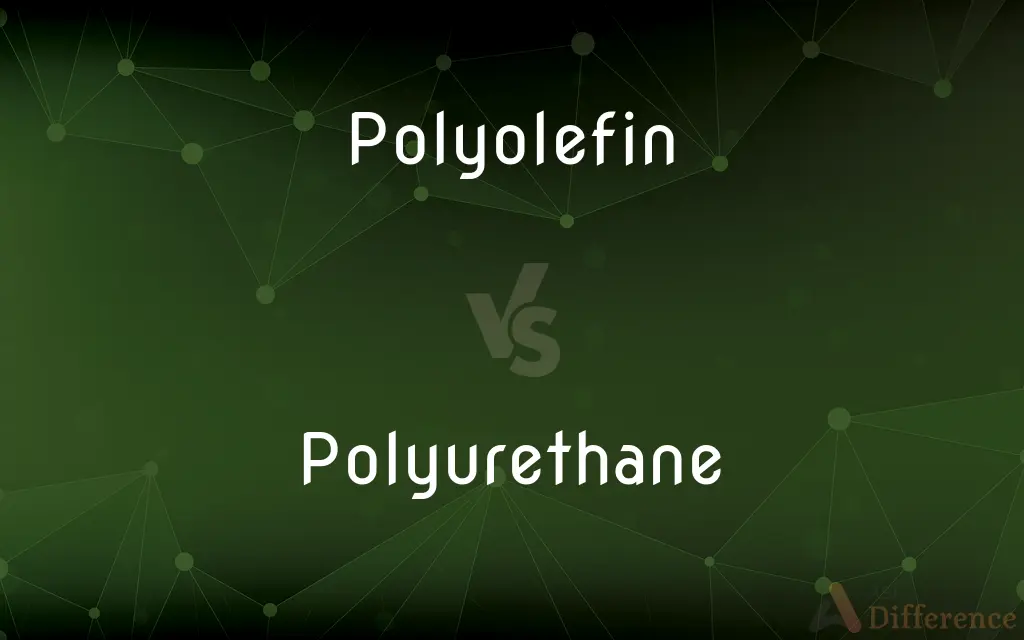Polyolefin vs. Polyurethane — What's the Difference?
By Fiza Rafique & Maham Liaqat — Updated on March 25, 2024
Polyolefin is a family of polymers derived from olefin monomers, known for chemical resistance and insulation properties; polyurethane is versatile, used in foams, elastomers, and coatings, characterized by its durability and flexibility.

Difference Between Polyolefin and Polyurethane
Table of Contents
ADVERTISEMENT
Key Differences
Polyolefin polymers, including polyethylene and polypropylene, are synthesized from simple olefins. They are renowned for their resistance to chemicals and excellent electrical insulation capabilities. These materials are widely used in packaging, textiles, and automotive parts. On the other hand, polyurethane is a diverse class of polymers formed by reacting a polyol with a diisocyanate or a polymeric isocyanate in the presence of suitable catalysts and additives. It stands out for its exceptional durability, flexibility, and resistance to abrasion and impacts, finding applications in furniture, footwear, automotive interiors, and insulation materials.
While polyolefins are generally more resistant to chemical degradation and exhibit better electrical insulation properties, polyurethanes excel in mechanical properties such as tensile strength, elasticity, and an ability to return to their original shape after stretching. This makes polyurethane more suitable for applications requiring durability and flexibility, such as in seals, gaskets, and elastomeric wheels.
Polyolefins are typically more cost-effective and easier to process in large volumes through methods like injection molding and extrusion. They are favored for their lightweight and recyclable properties, making them ideal for single-use products and packaging solutions. Conversely, polyurethane's versatility allows it to be customized into rigid foams, flexible foams, elastomers, and coatings, catering to a wide range of specific application needs, from cushioning materials to protective coatings.
The environmental impact and recyclability of these polymers also differ. Polyolefins, being simpler in structure and predominantly non-polar, are easier to recycle and have a lower environmental impact compared to some forms of polyurethane, which can be more challenging to break down and recycle due to their complex chemical structure and the presence of isocyanates.
In terms of thermal properties, polyolefins have a lower tolerance to heat compared to polyurethanes. Polyolefins tend to degrade or melt at lower temperatures, which limits their use in high-temperature applications. Polyurethanes, with their diverse chemical structures, can be engineered to withstand higher temperatures, making them more suitable for applications requiring heat resistance.
ADVERTISEMENT
Comparison Chart
Base Monomers
Olefins (e.g., ethylene, propylene)
Polyol and diisocyanate
Typical Uses
Packaging, textiles, automotive parts
Foams, elastomers, coatings, automotive interiors
Chemical Resistance
High
Moderate to high
Flexibility and Durability
Lower flexibility, high durability
Highly flexible and durable
Processing and Cost
Easier to process, more cost-effective
More complex processing, varies in cost
Environmental Impact
Easier to recycle, lower impact
More challenging to recycle, higher impact
Heat Resistance
Lower
Higher
Compare with Definitions
Polyolefin
A polymer made from simple olefins, notable for chemical resistance.
Polyethylene bags are a common form of polyolefin used in supermarkets.
Polyurethane
Known for its durability and flexibility.
Polyurethane seals are used in hydraulic systems due to their excellent performance.
Polyolefin
Characterized by excellent electrical insulation.
Polyolefin shrink wrap is used to insulate wires.
Polyurethane
A versatile polymer used in foams, elastomers, and coatings.
Polyurethane foam is used in mattresses for its comfort and durability.
Polyolefin
Has a lower thermal resistance compared to polyurethanes.
Polyolefin materials are not recommended for high-temperature applications.
Polyurethane
Suitable for high-temperature applications.
Polyurethane coatings are applied to protect surfaces from heat.
Polyolefin
Widely used in lightweight and recyclable products.
Polypropylene containers are favored for food packaging due to their lightweight nature.
Polyurethane
More challenging to recycle than polyolefins.
Recycling polyurethane products requires specialized processes.
Polyolefin
Cost-effective and easy to process.
Polyolefin films are produced economically for packaging.
Polyurethane
Customizable for specific applications.
Rigid polyurethane foams are used in insulation panels.
Polyolefin
A polyolefin is a type of polymer with the general formula (CH2CHR)n. They are derived from a handful of simple olefins (alkenes).
Polyurethane
Polyurethane (often abbreviated PUR and PU) is a polymer composed of organic units joined by carbamate (urethane) links. In contrast to other common polymers such as polyethylene and polystyrene, polyurethane is produced from a wide range of starting materials (monomers) and is therefore a class of polymers, rather than a distinct compound.
Polyolefin
(chemistry) A polymer (such as polyethylene) made by the polymerization of an olefin
Polyurethane
A synthetic resin in which the polymer units are linked by urethane groups, used chiefly as constituents of paints, varnishes, adhesives, and foams
Five coats of polyurethane
Polyurethanes serve a variety of uses
Polyolefin
(chemistry) A polyene
Polyurethane
Coat with polyurethane paint or varnish
The sanded and polyurethaned floorboards
Polyurethane
Any of various thermoplastic isocyanate polymers, widely varying in flexibility, used in tough chemical-resistant coatings, adhesives, and foams.
Polyurethane
(organic chemistry) Any of various polymeric resins containing urethane links; used in very many industrial and domestic applications.
Polyurethane
Any polymer containing [-NH.CO.O-] linkages; such polymers are much used as the basis of light but rigid foams for packaging (polyurethane foam) and for hard coatings, as on floors.
Polyurethane
Any of various polymers containing the urethane radical; a wide variety of synthetic forms are made and used as adhesives or plastics or paints or rubber
Common Curiosities
Can polyurethane replace polyolefin in all applications?
No, due to differences in chemical resistance, flexibility, and cost, polyurethane cannot replace polyolefin in all applications.
Why are polyolefins widely used in packaging?
Polyolefins are used in packaging due to their chemical resistance, lightweight, and recyclability.
Are all polyolefins recyclable?
Most polyolefins, like polyethylene and polypropylene, are recyclable, but recycling rates can vary based on local infrastructure.
How does the cost of polyolefins compare to polyurethanes?
Polyolefins are generally more cost-effective and easier to process, making them cheaper for certain applications than polyurethanes.
How do processing methods differ between polyolefins and polyurethanes?
Polyolefins are typically processed through extrusion or injection molding, while polyurethanes require more diverse processing techniques due to their varied forms.
How do polyolefins and polyurethanes differ in environmental impact?
Polyolefins generally have a lower environmental impact and are easier to recycle compared to polyurethanes, which can be more challenging to break down.
What is the significance of polyurethane in automotive applications?
Polyurethane is crucial in automotive applications for its role in manufacturing durable, comfortable interiors, and insulation materials.
Can polyurethane be used outdoors?
Yes, polyurethane is suitable for outdoor use due to its durability and resistance to weather conditions.
What makes polyurethane more flexible than polyolefin?
Polyurethane's chemical structure allows for more elasticity and flexibility compared to the simpler structure of polyolefins.
Are polyolefins suitable for electrical insulation?
Yes, polyolefins are excellent electrical insulators and are commonly used in electrical applications.
Why is polyurethane preferred in furniture manufacturing?
Polyurethane offers superior comfort, durability, and resistance to deformation, making it ideal for furniture, especially in cushioning.
Is there a difference in the wear resistance between polyolefins and polyurethanes?
Polyurethanes generally offer better wear resistance and can withstand abrasion and impacts more effectively than polyolefins.
Can polyolefin materials withstand high temperatures?
Polyolefins have a lower tolerance to heat compared to polyurethanes and may degrade at lower temperatures.
Share Your Discovery

Previous Comparison
Amable vs. Cordial
Next Comparison
Aristocracy vs. GentryAuthor Spotlight
Written by
Fiza RafiqueFiza Rafique is a skilled content writer at AskDifference.com, where she meticulously refines and enhances written pieces. Drawing from her vast editorial expertise, Fiza ensures clarity, accuracy, and precision in every article. Passionate about language, she continually seeks to elevate the quality of content for readers worldwide.
Co-written by
Maham Liaqat















































